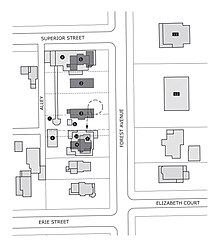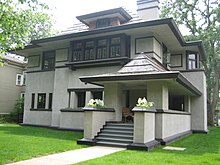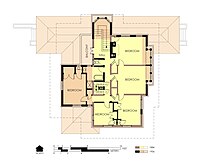Edward R. Hills House
Edward R. Hills House | |
Frank Lloyd Wright-Prairie School of Architecture Historic District (ID7300069 ) | |
| Added to NRHP | December 4, 1973 |
|---|---|
The Edward R. Hills House, also known as the Hills–DeCaro House, is a residence located at 313 Forest Avenue in the
Since construction, the home has undergone many changes. During the 1906 remodel, the original late 19th century Stick style structure was moved and essentially completely rebuilt. Alterations carried out between 1912 and 1965 obscured some of Wright's intended design. In 1976, a major fire destroyed or damaged much of the house. The house was immediately reconstructed and partially restored. This was furthered by another partial restoration by the current home owners. As a result of the remodels, the house today bears the work of at least four different architects. The house remains a private residence, but it is occasionally opened for special tours.
Early history
Frank S. Gray House (1883–1900)
In 1883, Dr.
Relocation and remodel (1900–1907)

Two years later in 1900, the Gray house changed hands again. It was purchased by attorney
Wright's design
Wright's design for the repositioned home – now in its third revision
The interior rooms were finished in keeping with the Prairie style. Walls and ceiling were plastered with ample oak trim throughout on both surfaces.[4][11] Floors in most rooms were also of oak. Large Roman brick fireplaces dominate the living room and master bedroom. As with most of his houses, Frank Lloyd Wright designed several built-in furnishings, including oak radiator covers, bookshelves in the library and living room, and a china cabinet with glass doors in the dining room.[12]

On the exterior, Frank Lloyd Wright traded the dual-pitched, cross-
Existing and new walls, alike, were covered in uniform, lightly textured, pale
The remodel brought ample exterior space to the house. Matching porches extended into the front and rear yard on either side of the north-facing, vertical entry and stair tower. Both porches were terminated in a broad stair between elongated planting
Hills ownership and alterations (1907–1965)
Although construction was completed sometime in late 1906 or early 1907, Nathan Moore's daughter did not move in right away. In fact, Mary was not wed to lawyer Edward Rowland Hills until January 1908. Instead, two successive families rented the house from Moore. The Hills resided at 335 Superior Street, a house located north of the Moore House until sometime in 1911 or 1912.[4][21]
Mary Hills was not particularly fond of her wedding gift. First, Wright was not commissioned to design furniture for the Hills; according to their eldest of five sons, John Moore Hills, they felt that "it was their house and they would furnish it for their own taste and comfort."
When Nathan Moore had split his property in 1910, he deeded the southern 60 feet (18.3 m) of his original 250 feet (76 m) of Forest Avenue frontage to his daughter. Since the two yards remained contiguous, the fact that the dividing lot line was tight up against the side of the Hills House posed no problem. However, in 1946, Nathan Moore died and his estate passed to the Hills family. Mary and Edward sold the Moore house the next year, but retained an additional 40 feet (12.2 m) of land to provide space for a side yard and garden north of their home.[4] Following her husband's death in 1953, Mary Hills continued to reside in the house until she sold it and moved to an apartment in 1965.[12]
Fire and reconstruction (1975–1977)
In 1975, Tom and Irene DeCaro purchased the house and began a diligent restoration with the aid of architect John Tilton.[12] However, work was abruptly halted in 1976 when a fire devastated much of the structure. Cleaning fluids and paint fumes ignited by an electric sander on the second floor were determined to be the cause of the blaze. Irene DeCaro was injured in the fire when she returned to the burning home to search for her pet cat. The entire second and third floors were completely destroyed and the first floor was badly damaged. Despite the extensive destruction, several of the first floor built-in furnishings and both fireplaces survived the fire.[22]
Following a neighborhood fundraiser in May 1976, Mr. and Mrs. DeCaro resumed their extensive reconstruction. The restoration returned the front elevation to its 1906 design yet retained most alterations made by the Hills towards the rear, including the enclosed porches and enlarged kitchen wing. In cases where
Recent years (1977 to present)

Following the DeCaros, the house passed through three owners before it was purchased by Mark and Sallie Smylie in 2001.[4][11] The Smylies hired Von Dreele-Freerksen Construction for restoration and remodeling work of the interior and exterior. On the interior, the modern kitchen and main floor bath were remodeled to match the style of the other ground floor rooms. In the basement level, the floors were lowered to increase ceiling height and stone foundation walls from the 1884 house were re-exposed. Outside, previous owners had installed a wood band below the first floor to match the ledge on the second floor, had capped some of the exterior planters, and had again replaced the cedar roof with asphalt shingles. All of these historically inaccurate modifications were reversed.[24] Additionally, trim and stucco were sampled to reveal the original exterior colors. The determined paint scheme consisted of off-white stucco and wood trim in dark "creosote" brown.[4]
On January 7, 2002, the Hills-DeCaro House was declared a landmark by the Village of Oak Park.
In early 2009, the Smylies embarked on their most significant exterior project. Records at Taliesin showed plans for a long pergola and pavilion which would have spanned between the Nathan G. Moore House conservatory and the northwest corner of the Hills-DeCaro House backyard. Further research yielded a period photograph which proved the structure's existence. Subsequent digging uncovered the limestone foundation for the pavilion. The Smylies and Von Dreel-Freerksen set about recreating the pavilion and the first section of the pergola (the portion which falls within the property lines of the Hills DeCaro House). Roman bricks for the new construction were matched to remnants found near the buried foundations. As part of the project, a large modern garage built in 1978 was replaced by a smaller, more historically sympathetic garage.[27][28]
Comparison to other Wright works

The Hills-DeCaro House is most significant for its architecture which represents the transition and integration of Wright's early experimental style and his mature Prairie style.
Elements which are purely Prairie in style include the extensive use of stucco contrasted with dark wood banding.[29] Several later works, such as the Stephen M. B. Hunt House and Robert W. Evans House share similar detail work and employ the same rectangular frames at each corner.[32] The horizontal emphasis created by this banding, as well as the deep overhangs and window groupings is also a hallmark of the Prairie style. The arrangement of rooms in the first floor of the Hills House and extended porches are evocative of the pinwheel shape found in the Ward W. Willits House, Darwin D. Martin House and other works.[33] As Wright broke away from the conventional, rectangular floor plans with the development of his Prairie homes, the hidden entrance also became more common and can be found in nearly every one of his Prairie houses.[34]
One component which epitomizes the transitional nature of the Hills-DeCaro House is the dual-pitched, Japanese inspired roof which recalls similar roof designs for the Harry C. Goodrich House and George W. Smith House, both completed ten years prior.[35] However, the cantilevered eaves of the Hills-Decaro house are even deeper – stretching 5.5 feet (1.67 m) on the upper story[5] – and the fascia is even thicker than those of its early predecessors. When paired with the unique, stepped shingle pattern, these adjustments further accentuate the Prairie style horizontality of the house.[4]
Other Wright house remodels in Oak Park
- 1894 Dr. H. W. Bassett House (demolished 1922)
- 1895 Harrison R. Young House
- 1896 Charles E. Roberts House
- 1896 Charles E. Roberts Stable
- 1906 Peter A. Beachy House
- 1909 William H. Copeland House
- 1922 Nathan G. Moore Residence(original house had also been designed by Wright in 1895)
See also
Notes
- ^ Oak Park HPC 2002, p. 39†
- ^ Hammons 1985
- ^ Gebhard & Gebhard 2006, pp. 46–48
- ^ a b c d e f g h i j k l m Gunning 2002
- ^ a b c Lesniak 1999
- ^ a b c Oak Park HPC 2002, p. 12
- ^ Gunning 2002 (Subpage: "Gray family house")
- ^ Lesniak 2008, p. 12
- ^ Oak Park HPC 2002, pp. 6, 14
- ^ Lesniak 1999 Refer to set of Wright floor plans
- ^ a b c d Beers 2003
- ^ a b c d Oak Park HPC 2002, p. 14
- ^ Curtis 1996, p. 117
- ^ a b O'Gorman 2004, p. 208
- ^ a b Oak Park HPC 2002, p. 6
- ^ a b Oak Park HPC 2002, p. 7
- ^ McAlester & McAlester 1994, p. 442
- ^ Oak Park HPC 2002, pp. 6, 7
- ^ Gunning 2002 Refer to historic photograph
- ^ Oak Park HPC 2002, pp. 7, 11
- ^ Oak Park HPC 2002, p. 13
- ^ Anonymous 1976
- ^ Oak Park HPC 2002, p. 15
- ^ O'Gorman 2004, pp. 207–208
- ^ Oak Park 2006
- ^ Oak Park HPC 2002, p. 4
- ^ Trainor 2009
- ^ Kaarre 2008, pp. 5–6
- ^ a b Oak Park HPC 2002, p. 10
- ^ O'Gorman 2004, pp. 38, 42
- ^ Stipe 2007
- ^ O'Gorman 2004, pp. 245, 255
- ^ Wright 1983
- ^ Watson 2010
- ^ O'Gorman 2004, pp. 90, 94
| † | Given nonconsecutive page numbering, any given page numbers refer to the page within the PDF instead of the number displayed on that page. |
References
- Anonymous (January 4, 1976). "Wright landmark burns; 1 hurt". Chicago Tribune. Chicago.
- Beers, Peter (May 2003). "Hills-DeCaro House: Oak Park, Illinois". Frank Lloyd Wright Road Trip. Retrieved March 31, 2010.
- Curtis, William J. R. (1996). Modern Architecture Since 1900. London: Phaidon Press Limited. p. 117. ISBN 978-0-7148-3356-9.
- Gebhard, David; Gebhard, Patricia (2006). Purcell & Elmslie : prairie progressive architects. Salt Lake City: Gibbs Smith. OCLC 64510725.
- Gunning, Don (2002). "313 Forest". Frank Lloyd Wright's Forest Ave. / dgunning.org. Retrieved March 23, 2010.
- Hammons, Mark (1985). "Biographical Notes: William Cunningham Gray (1830–1901)". Guide to the William Gray Purcell Papers. Retrieved March 29, 2010.
- Lesniak, Jack (December 2008). "December 2008 Trivia". Wright Now. p. 12. Retrieved March 30, 2010.
- Lesniak, Jack (1999), Wright Plus 1999 Research Report, Chicago: Frank Lloyd Wright Preservation Trust
- Kaarre, Doug (November 2008). "HPC 08-68: 313 Forest Avenue (Smylie) – Certificate of Appropriateness" (PDF). Historic Preservation Commission minutes – December 11, 2008. Archived from the original (PDF) on July 24, 2011. Retrieved April 13, 2010.
- McAlester, Virginia; McAlester, Lee (1994) [1984], A Field Guide to American Houses (11th ed.), New York: Alfred A Knopf, Inc., p. 442, ISBN 0-394-73969-8
- Oak Park Historic Preservation Commission (2002). "Oak Park Landmark Nomination Form (Hills-DeCaro House)" (PDF). HAARGIS Database. Retrieved April 12, 2010.
- O'Gorman, Thomas J. (2004). Frank Lloyd Wright's Chicago. Thunder Bay Press. ISBN 1-59223-127-6.
- "The Oak Park Home Remodeling Project". Quality Home Remodeling Magazine. June 11, 2010.
- Stipe, Margo (2007). "Frank Lloyd Wright Biography". The Frank Lloyd Wright Foundation. Archived from the original on March 4, 2017. Retrieved April 6, 2010.
- Trainor, Ken (October 13, 2009). "The Wright Delta". Wednesday Journal Homes. Retrieved March 24, 2010.
- Watson, James R. (2010). "The Work & Influence of Frank Lloyd Wright in Dallas/Ft. Worth Texas". Retrieved April 7, 2010.
- Wright, Frank Lloyd (1983). Drawings and Plans of Frank Lloyd Wright; The Early Period (1893–1909). New York: Dover Publications, Inc. pp. Plate XXV, Plate XXXII(b). ISBN 0-486-24457-1.
- Village of Oak park (2006). "Oak Park Historic Landmarks" (PDF). Archived from the original (PDF) on July 24, 2011. Retrieved April 12, 2010.
External links
- Historic photo of the Gray house prior to the 1906 Renovation (on dgunning.org – Virtual Tour of Forest Avenue); The wall at left with the first floor bay window forms the front (east) façade of the house today.







